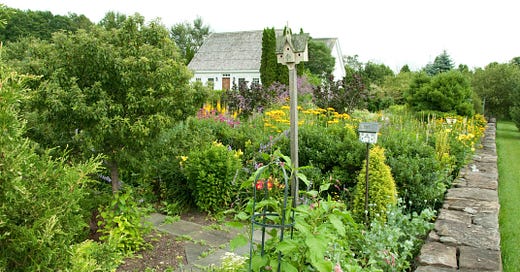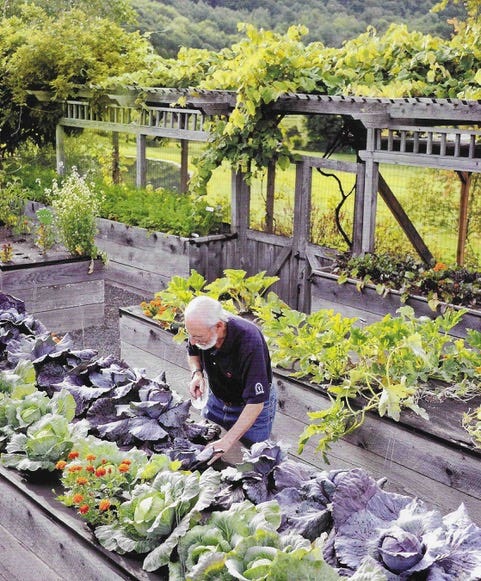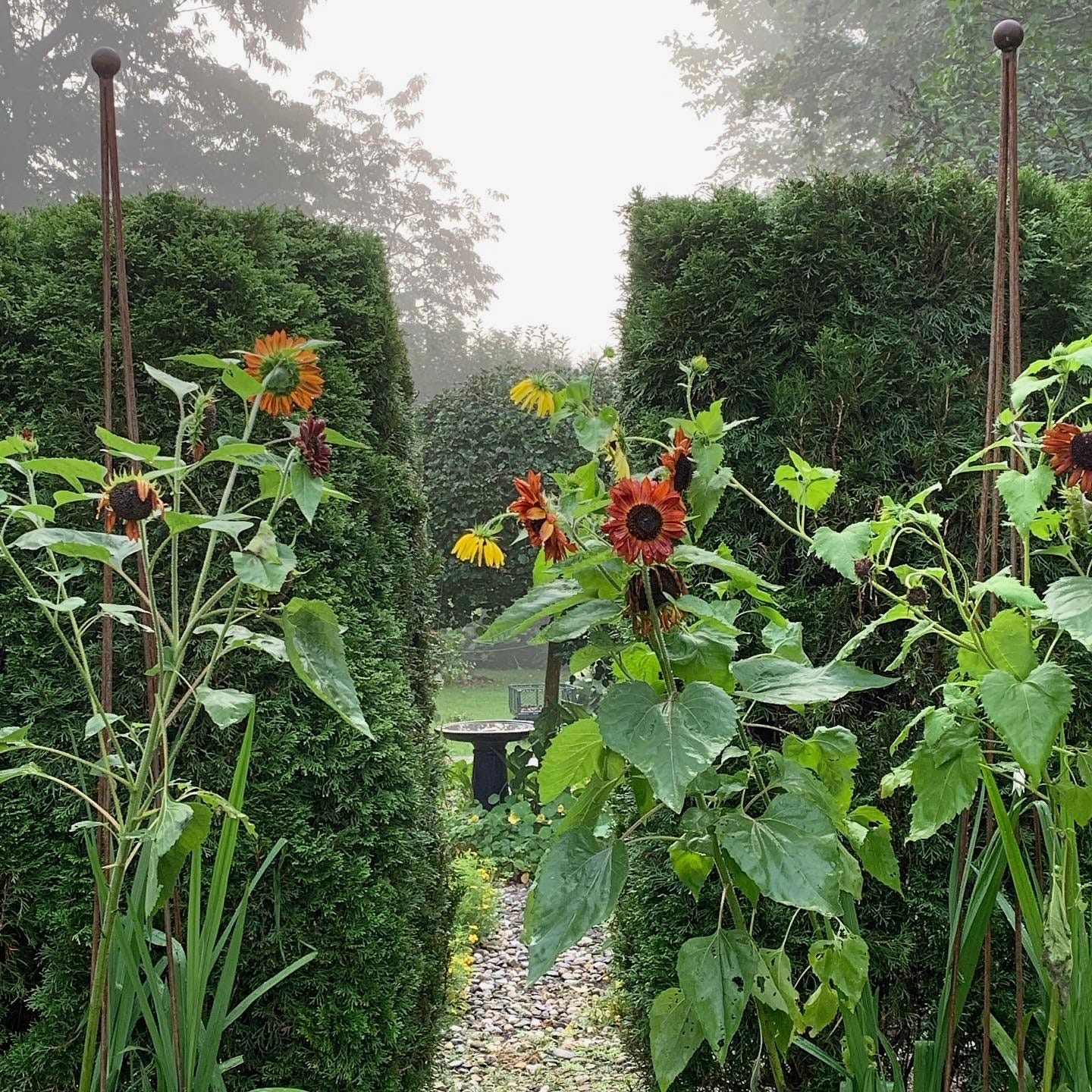“The garden suggests there might be a place where we can meet nature halfway.” — Michael Pollan
Hello Friends.
This time of year, I spend far too much time watching the birdhouses posted around my small yard. There are seven. Binoculars in hand, I wait patiently to see who has returned from the winter and who will establish a nest first. Like having bird feeders, it's the only way I can get to know how I'm doing on the scale of gardening for wildlife. Leaving hedgerows and seed pods around my yard gives birds and other creatures food and safety, which is the real reason I garden.
So when I am asked for garden advice, which happens frequently this time of year, it is never a simple yes or no answer. It usually involves talking about how our gardens are not just about growing plants to suit a gardener's whim but how we can build connections and create a sanctuary.
On my way to yoga class this morning, a friend asked, "I am considering buying a Corten steel raised bed for a new garden." Noting my lack of enthusiasm, she added. "They are a big investment but will last a long time. And I've read that the steel adds nutrients to the soil. What do you think?" Like being a doctor, when asked for free advice outside of the office, I don't mind if it can be helpful to a new gardener. But I had to be honest.
My friend did not get a simple yes or no because the answer is complicated. Especially when it involves soil. The issue for me is not the type of raised beds or the design ( and if it’s true that the steel will boost nutrition to soil) but the value of properly managed soil. Soil is the key to any garden, and raised beds pose a particular issue many gardeners never consider. Especially new gardeners, when they want that instant garden, "What are you filling the beds with?" I inquired, trying to be neutral. "And how will you keep the soil fresh each year?"
Raised beds are a prickly issue for me. As a garden designer, I do not like something that does not fit aesthetically or naturally into a landscape. Raised beds dry out faster than a typical in-ground garden, and it is harder to 'think outside the box' when planting them creatively and artfully. Box-shaped gardens are limited to straight rows either going sideways or diagonally and coming up with different variations is limited.
But that's not the real reason. Most gardeners plant a food garden to be productive, not artful. I often don't share my opinion about raised beds unless asked; I know many gardeners would disagree. Raised beds are convenient and optimal for urban gardens, where soil is no longer viable. If the purpose is to inspire more people to grow a food garden, it doesn't help to start with a negative tone.
My real disagreement is that a raised bed is often filled with bagged soil; even if it is organic, it will come in multiple plastic bags. This concept is akin to buying bottled water; it comes from someplace else that is unknown, yet because it is wrapped in plastic, it must be safe to consume. The consumer doesn't know where it came from or what it contains and is deemed “sterile” because it lacks any life form. Yet we make compost daily when we prepare a meal, and food waste is soil. What comes from the garden should go back to the garden.
Soil is a living, breathing organism that deserves to be treated with respect. After all, what feeds your plants ultimately feeds you. We can do better.
My deep love and appreciation for my soil keeps me constantly working to build the health of my soil. Soil is like magic, not an inert growing medium in a bag. It is a living and life-giving natural resource teaming with billions of bacteria, fungi, and other microbes that form an elegant symbiotic ecosystem. It fluctuates every year depending on what was grown the year before and requires constant nurturing regarding cover crops, compost, and crop rotation. Soil has been here long before we have, and it is our responsibility to make sure we leave it in optimal condition when we leave.
Most organic gardeners practice four-square crop rotation, designing their gardens into a four-square grid that allows plant families to be grown together and rotate each year to a different plot. This builds the soil and reduces soil-borne disease and pests. I practice this method as best as I can.
Nutrient-rich soil contains microorganisms, earthworms, small beetles, and mycorrhizal synergy that knit together a relationship that is a natural boost to a plant's root system. Often active in the spores from compost, the benefits of using the existing soil from your landscape are the only way to build a direct connection to the food you eat from your garden. If you fill a garden with sterile, weed-free soil, you are missing out on the power of soil to keep plants and people healthy from disease.
When I first began gardening many decades ago, I read that eating a little soil was a good way to keep your gut enriched with probiotics that matched the place where you live. I don't actively eat soil, but a little soil eaten from a washed, unpeeled carrot or potato will offer enzymes that enhance my connection and knit us together like a team. Not scientifically proven, but there it is.
After class, my new friend hung around a little longer to keep talking. She explained that she wanted a garden but didn't know where to start. I understand; I've been there before. We all must start somewhere. "I'll come to your house, and we can find a good place to put in a real garden," I said. "A place that resonates with your long-term goals and allows you to use your own soil." She smiled. I did, too.
Patience is imperative in the spring when watching for birds to return and when working with soil. Take a moment to cup a handful of soil, put it to your nose and inhale deeply. Healthy, organic soil smells sweet, like chocolate cake, and feels rich and crumbly in your palm. Soil and birds go together in spring; each relies on the other for food and sanctuary, providing a foundation and giving us hope.
From my kitchen garden to yours,
Ellen Ecker Ogden
p.s. As a Vermont writer and kitchen garden designer, my books are written for cooks who love to garden with recipes and garden designs. If you are new to this newsletter, Welcome! I am an artist turned gardener, and write about artful kitchen garden design to inspire growing a food garden that can turn work into play. My website is under construction, so I encourage you to follow me on Instagram. Thank you!










Ahhhh thank you for this!! Beginner gardener here (I’m in my second year!) and I did the thing you see promoted on Instagram so often when I started out— I had raised beds built. They cost a fortune. Not really the bed part, but the amount of soil, sand and compost!! About two months after I installed my raised beds, I learned about in ground planting and felt silly for investing in the “wrong” thing. But I course corrected.
I live in an urban area and my long term goal for my yard/garden is to do just what youve described above. I want to nurture and invest in rebuilding and fortifying my small plot of land in the city as best I can.
This year I started my first in ground garden bed. I currently have cover crops growing in it. Hoping to add a bed every year and see how we go!
Thanks for this post!!!!
Loved your post, Ellen! Your passion for gardening as a wildlife sanctuary shines through. Watching birdhouses with binoculars is such a vivid image. Your take on the Corten steel raised bed question was spot-on, especially about soil. The way you describe soil, sweet like chocolate cake, makes it feel alive. Great tie-in with birds and spring patience.